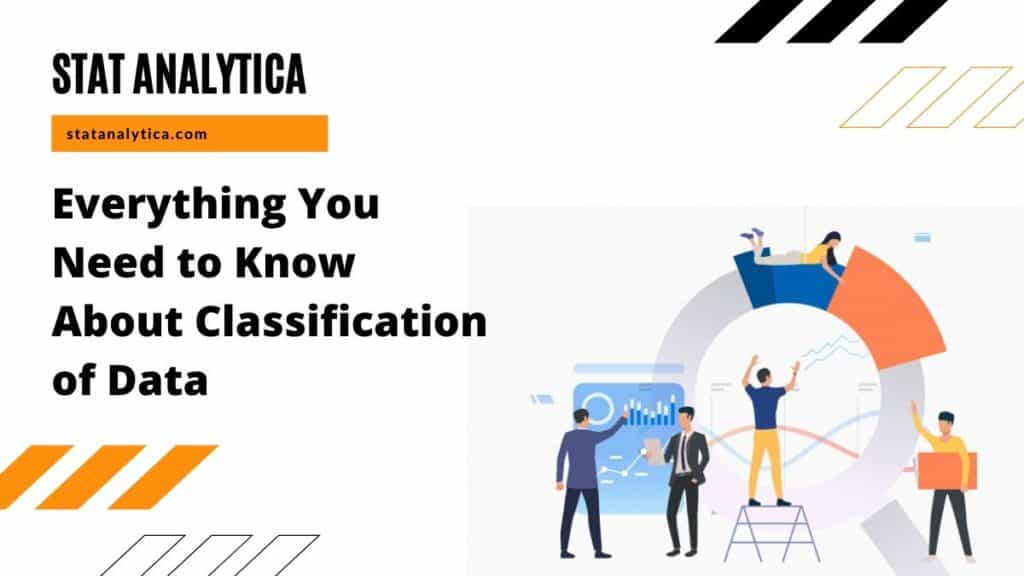Classification of data is an essential aspect of statistics. It is the way to organize the data in an efficient way. That is quite useful to perform the statistics operation on the data without any hassle. Most of the students may not be aware of the classification of data. But as statistics experts, we have to help the students to clear all their doubts. Here in this blog, we will share with you the best guide on the classification of data. Let’s begin with the introduction:-
Introduction of Classification of data
Table of Contents
Data classification is defined as the way to organize the data by relevant categories. Therefore it makes the data quite easy to use for the data analyst. The data classification is used for legal discovery, risk management, and compliance. There can be different guidelines for data classifications vary from organization to organization.
Apart from that, the data can also be protected more efficiently. Besides, when you do the proper data classification, then you can quickly locate and retrieve the data. Tagging data is also available in it to make it easily searchable and trackable. It also reduces the risk of duplication of data. Therefore the data storage also decreases, and it can be cheap to backup the data. Besides, whenever you want to perform any operation on the data, then the process will also be done at a rapid pace. In some cases, it is is quite tricky and technical.
Objectives of Data Classification
The primary objectives of data classification are:
- The major motive of data classification to arrange the high volume of data in a way that the similarities and differences can be understood without any hassle.
- For comparison aid.
- For pointing out the important characteristics of the data.
- It is used to give importance to the prominent data collected and used to separate the other optional elements from that data.
- You can also perform the statistical method on the collected material data.
- It is used to highlight the similarity in data.
- We use it for distinctiveness in data with the help of groping the data into different classes and classifications.
- It is useful for the scientific arrangement of data that makes the data more reliable.
- It is useful for data more precise and reduce redundancy.
- With it you can make changes in data more effectively and without any hassle.
Why do you need classification of data?
Data classification is exciting from the ancient era. But it is improving time over time. As we know that nowadays, technology is everywhere. And all these technologies are used to store the data. Therefore these technologies require it for easy access, maintaining regular compliance. Apart from that, the data analysts are using it regularly. They used it to search and retrieve the data. The best part of data classification is data security. It ensures data security and restricts the data being retrieved, transmitted, and copied. Here are some of the benefits of data classification:-
Confidentiality
With data classification, you can develop a system where you can allow the users to access only the limited data. It can only happen with the proper classification of the data. In this way, the most sensitive information with a limited number of users. E.g., the admin of a particular system can access all the data, but the users can only access the data which is provided by the admin. The most common technology used in this system is encryption.
The integrity of data
It allows you to get the integrity of data. In other words, the data is integrated with the other organized data, and the users require permission to access the data. It happened in a well-organized manner.
Availability of data
In this, the data can be available to a large number of audience with proper security and ease of access. There is no need to search for particular data to perform any statistics methods. Due to well-organized data, users can easily search for the data.
Steps for Effective data classification
We should know that all the data doesn’t need to be classified. Only some most critical data should go through the process of classification and reclassification process. Nowadays, data scientists and other data professionals have created the framework to organize the data. All they need to do is the assignment the raw data to the software to sort the data into different categories. They need to make sure that the classification of data will also solve the future requirements of statistics operations.
Scan
It is the initial step and involves the process where we analyze the entire database. In this process, we analyze every single database to get the raw data.
Identify
In this step, we identify the types of data that we need to insert in different categories. E.g, we can put the age and gender data into the demographic category. Similarly, we can put the job designation in the profession category. In some cases, we also identify the data as per character types or integer types.
Separate
In this step, we separate the data which is no longer required to perform. For example, in the demographic category, we also put the weight measurement data, which is no longer useful for our data operations. In this case, we separate this data from the demographic category.
Creating a Data Classification Policy
This is the step to generate the data classification policy. Every organization has its own data classification policy. So be careful while creating the data classification policy because it will affect the business in the long run.
Prioritize and Organize Data
Last but not the least step. It is time to implement the data classification policy on your data. You have to prioritize the sensitive information to sort first rather than the insensitive one.
Types of Classification
There are three types of data classifications.
(1) One -way classification
When we are going to classify data based on the single characteristics, then this type of classification is known as one-way classification.
For example, The students of the school may be classified by gender as girls or boys.
(2) Two -way classification
In this classification we do the classification based on two characteristics at a single time.
For example: The students of the school may be classified by gender and age.
(3) Multi-way Classification
In this we classified the data on the basis of multiple characteristics at a single time on the given dataset.
For example:- The students of the school may be classified by gender, age, height, weight, etc.
Basis of Classification
The data can be classified with various characteristics, depending on the purpose of our requirement and study we are going to perform on the data. Here are some basics of classification of data:-
Geographical classification
In this, we classify the data according to different locations. The location can be a city, state, country, or even continent. E.g. classification of the data of the income of the professionals in various cities of new York.
Chronological Classification
In this, we classified the data based on time. That’s why this classification is known as chronological classification. e.g., the classification of the data about the number of deaths from COVID 19 in the US in the last month.
Qualitative Classification
As the name suggests in this classification we do classified the data according to the qualities of data. As we know that qualitative data is far different than quantitative data. We can not measure the qualitative data with the help of numbers such as 3, 20, 40, etc. Qualification is further divided into two types:
- Simple: In this qualitative data, we exactly divide the data into two different groups. In the first group, we put the data of those users who have fulfilled the requirement, and the other is doesn’t. E.g., the educated and the uneducated group of the citizens.
- Manifold: In this, we classified the data according to more than one characteristic of an attribute. In other words, we classified the data into two different groups, then divided these two groups into two more different groups based on some quality. There is no limit of classification of data with this classification that has generated from just two groups. For example, the classification of data about students in a class as per their age followed by classification as per their height.
Quantitative or Numerical Classification
Quantitative classification can be done with the help of numerical values. In this, we can divide the data into different groups with numerical values. Besides, we range each group with the higher and the lower value. In this classification we can classify the numerical value of the data based on different regions and time. Quantitative classification is totally based on variables. Thus we also know it as classification of variables.
Conclusion
Now it may be clear in your mind what is the classification of data, how it works, and the importance of it. Next time whenever you are going to do it. Then you may be quite confident to use it. If it is still overwhelming for you to understand the classification of data. Then you can take the help from your statistics homework helper. We are offering the best statistics homework help to the students. You can get the math assignments from our best expert in math.


